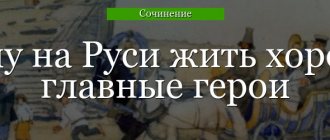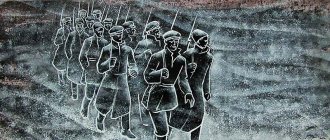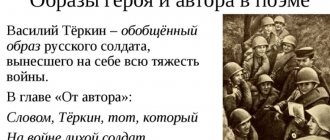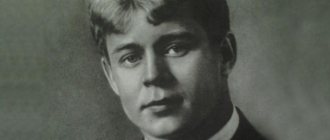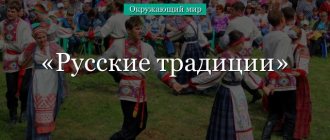- Essays
- On literature
- Nekrasov
- The image of peasants in the poem Who Lives Well in Rus'
The image of the peasants in Nekrasov’s poem “Who Lives Well in Rus'” is very twofold; the author himself seems to divide all peasants into those who are ready for a free life after the abolition of serfdom and those who are so accustomed to groveling before their masters that they... they cannot live for another.
From the very beginning, the reader meets seven main characters, freed after the abolition of serfdom, peasants who decided to argue about who should live well in Rus'. There is simply no point in talking about each of them separately, because Nekrasov put into their images a piece of the true Russian peasant, the totality of their characters is one big image of the Russian peasantry.
These men were tall, healthy, heroic. Based on the fact that they are very interested in how other people live, we can conclude that they are inquisitive. They are good-natured and sincere, incorruptible and value freedom, tired of constant oppression.
However, one should not exaggerate the positive image of the peasants, because they are not at all so ideal: they love to sip a glass, they see happiness in prosperity, and not in spiritual things, they constantly argue, and their disputes reach the point of assault. The main characters are also not endowed with the ability to write correctly; only one of them, Demyan, is able to read syllables. The most stubborn of the peasants is Luka, who was stupid and previously served with the priest.
Nekrasov, with the help of other people whom the main characters meet along the way, tells us about how the peasants of that time really lived. For example, Yakim , who put all his strength and soul into the land, lived very poorly and did not have a penny to his name, although he was a very hardworking peasant. Yakim lost his last money when he sued a merchant in St. Petersburg and lost the case. Nekrasov says that at that time there were a lot of such ships.
The positive sides of the peasants are also manifested in the two other heroes encountered - Trophim and Agape. Agap does not want to bow to the master Utyatin and does not want to put on a performance for him, and when he is finally forced to do this, he dies the next day. This shows that it is easier for the Russian peasant to die than to submit.
Trofim, on the other hand, is the quintessence of tolerance and endurance; he was able to endure fourteen pounds, after which he crawled home, barely alive.
Girin is endowed with absolute honesty , whom the people elect as burgomaster, but for his honesty and ideological spirit, Girin repays with freedom - he goes to prison.
Essay Peasants in the work Who Lives Well in Rus'
Nekrasov's work became the final stage in his work. This poem can rightfully be called a novel about the life of the people. The poet clearly and truthfully depicted the picture of Russia before and after the reform of 1861 and the changes that occurred. The author created the poem at a time when changes were inevitable, and everyone understood that ruin and bondage awaited the peasants.
At the very beginning, you can see how the men began to argue about who was living well. This suggests that it is they who have a difficult fate. They, in order to once again find the answer to their question, go to the villages. They want to see where they live happily. The men will walk through the Frightened Province, talk with the peasants of many villages, where they will learn about what is hard for the Russian people. On the way they will meet the priest and the master. It is here that the author contrasts two worlds - the people and the masters. The ruthlessness of the landowners and their despotism, which turned the villages into “Neelovs” and “Razutovs”, provides a clear contrast with the breadth and high morality of the peasants. Klim Lavin, Matryona Timofeevna, Yakim Nagoy - these and other peasants are depicted in more detail. The poet shows the beauty of their soul and nobility. But at the same time, Nekrasov notices their shortcomings.
He writes that the Russian peasant likes to drink and then go out on a grand scale. So, Yakim Nagoy says to himself that he works as hard as he can, but then drinks until he stupefies. But not all peasants tolerate the bullying of their masters. So, for example, Agap Petrov is tired of listening to the master’s speeches for his every dissatisfaction and he directly expresses to him everything that he thinks. As a result, he dies, unable to bear the violation of his human feelings. Another lover of truth is depicted especially clearly in the poem - this is Yakim Nagoy. He lives the same miserable life as all the peasants. But he intends to stand up for his rights. Matryona Timofeevna also lives hard. From an early age she worked like hell. Nothing has changed in her marriage, it has only gotten worse. Hard labor, abuse from her husband and the death of her baby befell her. And although her life was full of hardships and hardships, the woman remained kind and generous.
Showing the man as illiterate and rude, the author noted that he had not lost his intelligence and resourcefulness. One of these characters is Klim Lavin, who managed to cunningly gain the favor of the landowner and take the position of mayor in order to help his villagers. The robber Kudeyar and Yermil Girin, who ended up in prison defending the interests of the peasants, can be honorably called fighters for the rights of the humiliated. Nekrasov’s poem shows not only the time when life was especially difficult for peasants, but also the ways of struggle for people’s happiness.
Essay: Images of peasants in the poem “Who Lives Well in Rus'” (N.A. Nekrasov)
(347 words) The people in the epic poem by N.A. Nekrasov’s “Who Lives Well in Rus'” is a positive hero. The author pinned his hopes for the future on him, although he was aware of the weakness of peasant protest and the immaturity of the masses for struggle and revolutionary action.
The peasantry in the work is heterogeneous; it is represented by several groups. The majority are passive, but against their background those who realize the value of freedom, their own necessity, and who respect themselves stand out. These are the people's intercessors: Ermil, who takes the side of the rebellious peasants, headman Vlas and other heroes. Ekim Nagoy, a representative of the working peasants, especially stands out among them. He does not look like a downtrodden dark peasant of a patriarchal village. He ardently defends his honor and makes a fiery speech in defense of the people. No less important is the image of Savely, who is called the holy Russian hero. He personifies the resilience of the people. When Matryona talks about Savelya, she ironically says: “He was also lucky,” because she knows that this man lived a bitter and full of suffering life, but not in vain, because he was freedom-loving, fought for something that many had not yet realized. Savely, together with his comrades, killed the oppressor Vogel, who turned the peasants into tortured and driven slaves. For this he went to hard labor, but also escaped from there several times, not reconciling himself with injustice. It is no coincidence that he ends his journey in a monastery: the hero’s deep spirituality forces him to go in search of the truth that the people find in the Christian faith. Thus, the peasants in the poem appear not as ignorant rebels, but as tragic heroes on the level of Hamlet or Faust: they not only challenge fate, but also seek truth, goodness, and the meaning of being in a life filled with suffering.
Along with the positive peasant characters, there are other types, the advantage being the courtyard ones - the lordly sycophants and traitors. For example, such is Yakov, an exemplary slave, a slave at heart, capable only of killing himself and taking revenge on the landowner, or Shutov, a spy from among his own, or the headman Gleb, who agreed to destroy the landowner’s will on the release of eight thousand people for the sake of reward (chapter “ Peasant sin”). The images of these peasants are drawn in tones of satirical denunciation. The author condemns the slavish humiliation, servility, and spiritual poverty of forced people.
The poetic world of this poem is a world of sharp social contrasts and sharp contradictions. Nekrasov emphasizes the temporary nature of the dark sides of peasant life and hopes for the spiritual “growth” of people. It is in the people that he sees sufficient strength to develop Russia.
Author: Alika Latinskaya
Essay Peasants (Who lives well in Rus')
In the poem “Who Lives Well in Rus',” N. A. Nekrasov raises and examines one of the main problems of the Russian state, which is relevant to this day. The images of peasants as the main characters of this problem and, accordingly, the poem reveals its entire essence.
The writer creates a group portrait of seven peasants who travel around Rus' and look for happy people, among whom, they are sure, there are no peasants, soldiers and other lower classes. The author identifies the characteristics of wanderers: poverty, curiosity, independence. Nekrasov clearly points out the hostility of the peasants towards those who live and get rich for their work, while the poor peasants are pure in heart, honest in their work, and kind in soul. This can be seen in the described case with Matryona Timofeevna, when ordinary men came to her to help with the harvest.
The image of Yakima Nagoy personifies all the peasants who work tirelessly and live in starving poverty. HE works so hard that he already merges with the ground, which he plows day and night.
And he himself looks like Mother Earth: his brown neck, like a layer cut off by a plow, his brick face...
The myth that all peasants are poor because of drunkenness is not confirmed; in fact, the reason is in fate to work for the owner.
Ermila Girin wins over the reader with her honesty and great intelligence. After he framed a neighbor's boy as a soldier, he is tormented by his conscience instead of his brother. He is visited by the thought of suicide, but still he goes to the people to repent. The author introduces the image of Savely to demonstrate the idea that the people are heroes. Despite his illness, he knows how to empathize with others. Nekrasov gives him the role of a philosopher.
It is fashionable to see the female share in Matryona Timofeevna. She is strong-willed and resilient. Any successful merchant can envy her inner core. Her fate is so typical for all Russian women that she does not advise looking for a happy one among them. She, as the breadwinner of the family, is obliged to work and not spare herself and her strength.
Such images of peasants arise as a consequence of the reform of 1861. The peasants try not to look at the cruel reality and live in their own religious and humane world, which still treats them cruelly.
Images of peasants in Nekrasov’s poem “Who Lives Well in Rus'”
The famous poem by N.A. Nekrasov’s “Who Lives Well in Rus'” reveals and describes to readers the images of peasants who happened to experience the hardships and difficulties of the post-reform era in Russia. Nekrasov introduces us to ordinary peasant men who decided to find out who is really happy in Russia - a landowner, a merchant, a priest, or the Tsar himself? Seven wanderers travel around Russian lands in search of truth. They meet different characters along the way, but never refuse to help anyone. The travelers help out Matryona Timofeevna after learning that her crop is dying. The Illiterate Province also felt the help of the men.
Thanks to the wanderings of the heroes, Nikolai Alekseevich introduces readers to various persons who occupy completely different positions in society. This includes the clergy, the merchants, and the nobility. And against the background of them, the author can contrast with the representatives of the peasantry - the travelers themselves, with their distinctive character traits and behavior.
While reading the poem, we meet a poor peasant named Yakim Nagoy. He, working all his life, remained in the lavas of the most impoverished sections of the population. Most of the residents of the village of Bosovo are like him.
Analyzing the portrait of this hero, in which Nekrasov compares him to Mother Earth itself, calling his neck brown and his face brick, one can guess what kind of work he does every day and performs for the benefit of others. However, Yakim is not upset about his situation, because he believes in the peasants, that they have a bright and decent future.
Another Nekrasov character, Ermila Girin, was distinguished by his incorruptibility and honesty. In addition, he was unusually smart.
Using the example of this hero, Nekrasov shows how united the peasants were. The people trusted Ermila during the purchase of the mill, for which he takes the side of the peasants and supports their rebellion.
Repeatedly, when describing the image of a real peasant, Nekrasov mentions the heroes that many of them resembled. The image of Savely is a clear confirmation of this. He is tall, powerful and strong. And despite such peasant traits, Savely is an unusually sincere, kind and pure person. He treats Matryona Timofeevna with trepidation and love. Savely often falls into philosophical thoughts about whether the common people should endure all the humiliations and burdens that have fallen on the working shoulders.
As for the female images, to which Nekrasov paid considerable attention, their description merged into the person of Matryona Timofeevna. This is a woman who strived with all her might to fight for happiness, for freedom. She was strong and had extraordinary endurance and perseverance. Her fate was not easy. Having got married, she endured the trials of misfortunes and, ultimately, took up hard work along with the men.
Matrena Timofeevna
very often she poured out her emotions through songs. Nekrasov calls the song the soul of the people, because in it the peasants poured out all their pain, all the bitterness that burdened their difficult lives.
In addition, the text of the poem also contains characters of landowner servants who took the abolition of serfdom seriously. They are so used to serving and doing errands that they have completely lost their self-esteem and become faceless.
This is Yakov, who deals with himself in front of the master in order to take revenge on him. This is both Klim and Ipat. Ordinary peasants despise these people, and they hate the landowners even more. After all, they sold out and became spineless and low creatures.
In this field, Nikolai Nekrasov describes the strong stratification that occurred among the peasants. And the reason for it all was the reform of 1861.
Nekrasov, in the text of his poem, did not forget to mention that the peasants were unusually religious. Their faith in God, in the Almighty, was strongest. They turned to him for help, looking for protection and support. Only with hope and faith could the peasant representatives move forward to a happy life.
In the poem “Who Lives Well in Rus',” Nikolai Alekseevich revealed the images of typical representatives of the peasant class. The writer is trying to say that peasants are not just slaves, they are a force that can ultimately manifest and show itself. Therefore, it must be taken into account and endowed with its own rights and freedoms.
Did you like your school essay? And here's another:
Analysis of Nekrasov’s poem “Who Lives Well in Rus'” Images of landowners in Nekrasov’s poem “Who Lives Well in Rus'” Image of Matryona Timofeevna in Nekrasov’s poem “Who Lives Well in Rus'” Image of Yermil Girin in Nekrasov’s poem “Who Lives Well in Rus'”
Images of peasants in the poem Who Lives Well in Rus' Essay
The main idea of Nekrasov’s poem was to depict Russian peasants from the time when serfdom was abolished.
Throughout the entire poem, the heroes travel throughout Rus' in order to answer the question: “Who lives cheerfully, at ease in Rus'?”, who is in complete prosperity, happy, and who is not. Men seeking the truth
The main characters of the work come forward, seven men, wandering through Russian towns and villages, looking for an answer to a very difficult question. In the image of peasants there are the main features of poverty of ordinary Russian men, such as: poverty, curiosity, unpretentiousness. These men ask the same question to everyone who crosses their path. In their minds, the lucky ones are the priest, the merchant, the landowner, the nobleman and the Tsar Father himself. However, the main place in the author’s work is given to the peasant class.
Yakim Nagoy
He works until his death, but lives poorly and is constantly hungry, like the bulk of the residents of Bosovo. Yakim understands that the peasants are a great force and he is proud that he belongs to them, he knows the weak and strong points of the peasants’ character. It assumes that the main enemy of men is alcohol, which destroys them.
Ermila Girin
Yermila received honesty and intelligence from Nekrasov. He lives for the population, he is fair, he will not leave anyone in grief. There was one dishonest thing, he saved his nephew from recruiting. But he did this not for himself, but for the sake of his family. He sent his widow's son instead of his nephew. He was so tormented by his own lies that he almost led to hanging. Then he corrected the mistake and marched with the rebels, after which he was put in prison.
Savely the hero
The author admits the idea that ordinary men are like Russian heroes. Here the image of Savely, the Holy Russian hero, appears. Saveliy empathizes with Matryona from the bottom of his heart and takes Demushka’s death hard. This hero contains kindness, sincerity, and helping other people in difficult situations.
Matrena Timofeevna
All peasant women are shown in the guise of this woman. She has a powerful soul and willpower. Throughout his life he fights for the freedom and joy of women. Her life is similar to many peasant women of that time. Considering that after marriage she ends up in a family that despises her. Her husband beat her once, her first child was eaten by piglets, and she spends the rest of her life working in the fields.
